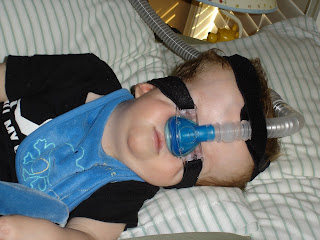Yipppeeeee! Dr. Fearon and Dr. Price agreed that if Jack's subdural shunt continues to drain as well as it has been doing, Jack will not need any major surgery for a few years. We will have fairly frequent CT scans on Jack's noggin so we can be sure that fluid is not building up. Jack's sleep apnea is a bothersome issue for everyone. Dr. Fearon is trying to delay doing Jack's midface surgery as long as possible because it is much more complicated when performed so young. Also, the earlier it is done, the more likely it will be needed again. If Jack does not do well with the CPAP then the next step will be a tracheostomy. Jack is doing better on the CPAP since we decreased the pressure.
Oh yeah, before I forget....for those of you who don't know what sleep apnea or CPAP is, I copied this from familydoctor.org:
"
What is sleep apnea?In some people, the windpipe that brings air into the body is blocked during sleep. This keeps the lungs from getting enough air. This is called obstructive sleep apnea. People who have sleep apnea stop breathing for 10 to 30 seconds at a time while they are sleeping. These stops can happen up to 400 times every night. The consequences of these disturbances can be serious and sometimes life-threatening.
Return to topWhat is a CPAP device?
One way to treat people who have sleep apnea is a continuous positive airway pressure (CPAP) device. A CPAP device has a mask, tubes and a fan. It uses air pressure to push your tongue forward and open your throat. This allows air to pass through your throat. It reduces snoring and prevents apnea disturbances.
You should put your CPAP device on whenever you sleep, even for naps. A CPAP device does not cure sleep apnea. But, when you use the device correctly, your sleep problems should get much better."
Here is my simplified explanation. Let's break it down. What is apnea? Apnea was originally a couple of Greek words meaning without wind. In other words, it means no breath, no air getting into the lungs. So what does obstructive mean? It is a big word. Obstructive is an adjective (a descriptive term) whose root word is obstruct. Obstruct can be defined "to fill (a passage) with a blockage." We all know what sleep is. So obstructive sleep apnea in my simplified definition means that a person's airway is blocked so that he cannot pass air into his lungs while sleeping. What causes the blockage? In Jack's case, his Apert syndrome causes him to have a narrow airway and extremely narrow nasal passages. When his muscles and tissues relax when he is asleep, the narrow passages become blocked up. When you add any congestion from allergies or a cold, the problem gets even worse because whatever space was partially open can get filled up with the secretions.
So how does the CPAP work? Jack has to keep a tightly fitted mask on his face while he is asleep. It's connected to basically what amounts to a small sophisticated air compressor with humidified air. The machine pumps out a large amount of air that sort of acts like a breathing tube. Think of it like a ventilator but there is no plastic going in Jack's throat. Instead there is a "tube" of air that holds Jack's airway open and allows him to continue breathing all night. Without the mask, Jack's airway partially collapses during sleep and he cannot get in enough oxygen which would cause heart, lung, and brain damage.
We are hoping that Jack will continue to make progress on tolerating the CPAP and we will all get a lot more rest.
So what's the next step? We have to contact Dr. Stager about doing Jack's eye muscle surgery. Right now, we are hoping that Dr. Stager will be willing to schedule Jack in about 3 months. That way, we can have our CT done in two months and if Dr. Price needs to do anything, she and Dr. Stager can coordinate so Jack requires only 1 anesthesia. We are hoping she won't need to do anything and Jack will have eye surgery by Dr. Stager and deepening of some web spaces and toenail ablation by Dr. Fearon.
I know we need more pictures and I promise to post some soon!











